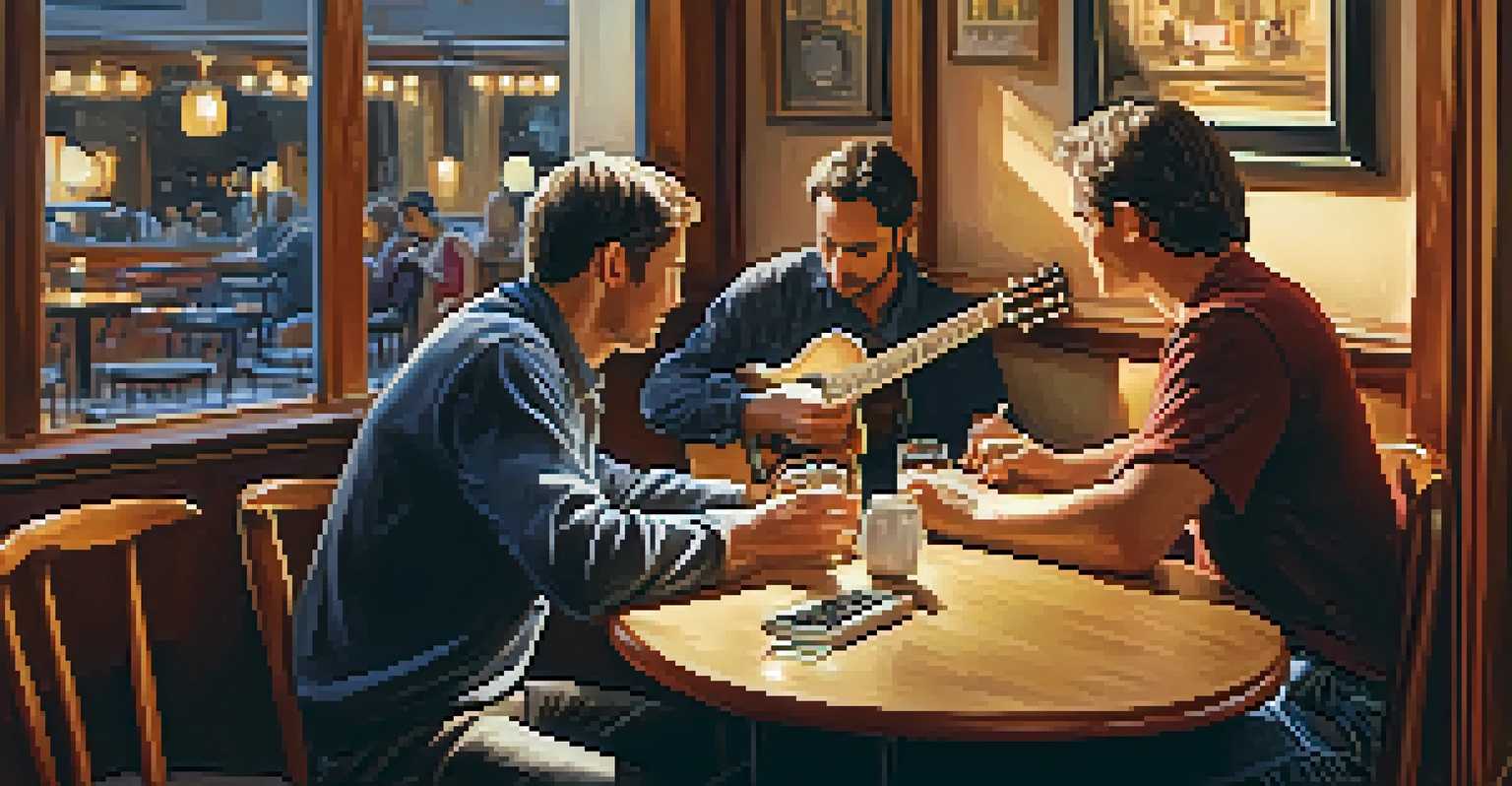Bossa Nova: Brazilian Guitar Techniques and Their Origins

Understanding Bossa Nova: A Brief Overview
Bossa Nova is a distinctive style of Brazilian music that emerged in the late 1950s. It blends samba rhythms with jazz influences, creating a smooth and sophisticated sound. The term 'Bossa Nova' translates to 'new trend', reflecting its innovative approach to music. This genre not only revolutionized Brazilian music but also captivated audiences worldwide, making it an enduring favorite.
Bossa Nova is not just a musical genre; it's a cultural movement that reflects Brazil's identity.
At its core, Bossa Nova emphasizes melody and harmony, often using complex chords that evoke a sense of longing and nostalgia. The guitar plays a pivotal role in Bossa Nova, serving as both a rhythmic and melodic instrument. Artists like João Gilberto and Tom Jobim were instrumental in popularizing these techniques, establishing a unique sound that is instantly recognizable.
As we delve deeper into Bossa Nova, it's essential to appreciate how its origins are tied to the cultural and social context of Brazil. The genre emerged during a time when Brazilian artists sought to express their identity in a rapidly changing world. This blend of tradition and modernity is what makes Bossa Nova so captivating.
The Essential Guitar Techniques of Bossa Nova
Bossa Nova guitar techniques are characterized by their intricate fingerpicking patterns and syncopated rhythms. Unlike traditional strumming, guitarists often pluck individual strings with their fingers, creating a soft, flowing sound. This technique allows for a greater expression of melody and harmony, as each note rings out clearly and beautifully.

A signature technique in Bossa Nova is the use of chord voicings that include extended harmonies, such as seventh and ninth chords. These richer chords add depth and complexity to the music, setting it apart from other genres. Additionally, guitarists often incorporate rhythmic variations, allowing for a playful yet sophisticated feel that keeps listeners engaged.
Bossa Nova's Unique Sound
Bossa Nova blends samba rhythms with jazz influences, creating a smooth and sophisticated musical style that resonates globally.
To master Bossa Nova guitar, it's crucial to practice these techniques slowly and deliberately. Starting with simple chord progressions and gradually adding complexity can help develop a strong foundation. For example, begin with basic chords and integrate fingerpicking patterns before tackling more advanced rhythms and harmonies.
Historical Context: The Birth of Bossa Nova
Bossa Nova emerged in Brazil during the late 1950s as a reaction to the vibrant samba and jazz scenes. Influenced by American jazz musicians, Brazilian composers sought to create a sound that reflected their cultural identity while also appealing to international audiences. This fusion of styles allowed Bossa Nova to flourish and gain popularity beyond Brazil's borders.
The beauty of Bossa Nova lies in its simplicity and the depth of its emotions.
The movement was closely tied to the intellectual circles of Rio de Janeiro, where artists, poets, and musicians collaborated to create a new cultural expression. The poetic lyrics of Bossa Nova often reflect themes of love, nature, and the everyday life of Brazilians. This lyrical depth, combined with its unique musical structure, resonates with listeners on a personal level.
As Bossa Nova gained traction in the 1960s, it began to influence various genres, including pop and rock music. International artists began to incorporate Bossa Nova elements into their work, further solidifying its place in the global music landscape. Today, Bossa Nova continues to inspire musicians around the world, showcasing the enduring power of its roots.
Influential Bossa Nova Guitarists to Know
When discussing Bossa Nova, one cannot overlook the impact of João Gilberto. Often referred to as the father of Bossa Nova, his innovative guitar style and soothing vocals helped define the genre. Gilberto's ability to blend rhythm and melody created a unique listening experience that captivated audiences and set the standard for future artists.
Another key figure in Bossa Nova is Antonio Carlos Jobim, whose compositions remain iconic to this day. Jobim's songs, such as 'The Girl from Ipanema,' showcase his mastery of harmony and lyrical storytelling. His collaboration with Gilberto and other artists further propelled Bossa Nova into the limelight, making it a global phenomenon.
Key Guitar Techniques
Intricate fingerpicking patterns and syncopated rhythms are essential techniques that define Bossa Nova guitar playing.
Additionally, guitarists like Baden Powell and Luiz Bonfá contributed their unique styles to the Bossa Nova movement, enriching its diversity. Each artist brought their own cultural influences and musical expertise, creating a tapestry of sounds that continues to evolve. Their legacies inspire new generations of guitarists to explore the beauty of Bossa Nova.
Essential Bossa Nova Chords and Progressions
Understanding the essential chords of Bossa Nova is key to playing this style effectively. Commonly used chords include major, minor, seventh, and ninth chords, which create the genre's characteristic sound. For example, the progression from D7 to G7 is a staple in many Bossa Nova songs, providing a smooth transition between harmonies.
In addition to these basic chords, Bossa Nova often employs substitutions and extensions to add richness. For instance, substituting a D7 with a D9 can create a more complex sound that enhances the overall feel of the music. Learning these variations can help guitarists develop their own unique interpretations of classic Bossa Nova tunes.
Practicing these chord progressions in various keys will also build familiarity with the genre's structure. As you experiment with different voicings and rhythms, you'll discover how these elements come together to create the enchanting sound of Bossa Nova. This exploration not only improves your guitar skills but deepens your appreciation for the genre.
The Role of Rhythm in Bossa Nova Guitar Playing
Rhythm is at the heart of Bossa Nova, influencing everything from guitar techniques to song structure. The genre's signature rhythms are derived from samba but are often played at a more relaxed tempo, giving it a laid-back feel. This distinct rhythm provides a foundation for the melody and harmonies, creating a cohesive sound that is both soothing and engaging.
Guitarists typically use a technique called 'batida,' which involves combining fingerpicking with a rhythmic strumming motion. This technique allows for a dynamic interplay between melody and rhythm, giving the music a sense of movement. Incorporating syncopation—where the emphasis shifts from the strong beats to the weaker ones—adds a playful quality that is characteristic of Bossa Nova.
Cultural Impact and Legacy
Bossa Nova has influenced a variety of genres worldwide, showcasing its enduring appeal and inspiring new generations of musicians.
To fully grasp the rhythmic nuances of Bossa Nova, it's beneficial to listen to various artists and styles within the genre. Pay attention to how different guitarists interpret the same song, as subtle variations in rhythm can significantly alter the feel of the music. This exploration will not only enhance your playing but also deepen your connection to Bossa Nova as a whole.
Bossa Nova Today: Its Influence and Legacy
Bossa Nova has left an indelible mark on the music world, influencing countless genres and artists. Its smooth melodies and intricate harmonies can be heard in contemporary jazz, pop, and even electronic music. Many musicians draw inspiration from Bossa Nova's unique sound, blending it with their own styles to create fresh interpretations.
Festivals and concerts celebrating Bossa Nova continue to attract audiences globally, showcasing its enduring appeal. New generations of musicians are exploring Bossa Nova techniques, ensuring that this rich musical tradition lives on. Online tutorials and social media platforms have also made it easier for aspiring guitarists to learn and share their passion for the genre.

As we look to the future, Bossa Nova's legacy remains strong, reminding us of the power of cultural exchange and musical innovation. Whether you're a seasoned musician or a curious listener, the enchanting world of Bossa Nova invites everyone to experience its beauty. Embracing this genre not only honors its roots but also celebrates the creativity it inspires.